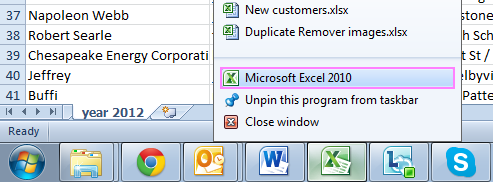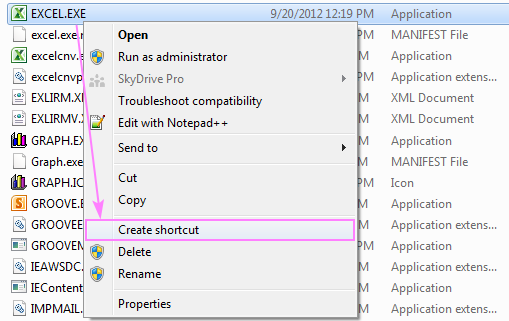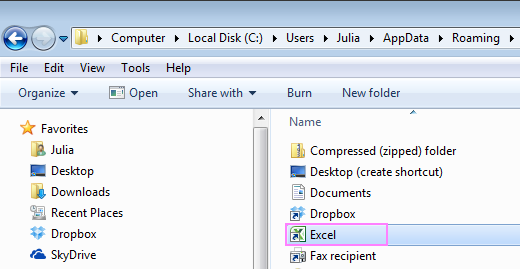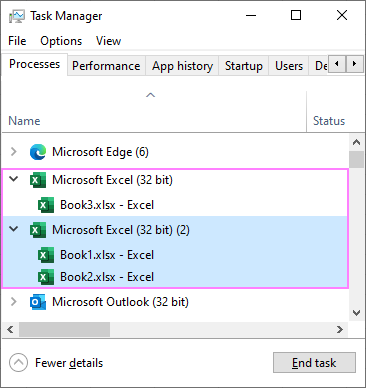How To Open 2 Excel Sheets In Separate Windows
This post describes the easiest ways to open two or more than Excel files in split up windows or new instances without messing with the registry.
Having spreadsheets in ii different windows makes many Excel tasks easier. Ane of the possible solutions is viewing workbooks next, but this eats a lot of infinite and isn't ever the all-time pick. Opening an Excel document in a new instance is something more than than just the ability to compare or view sheets next to each other. It's like having a few different applications running at the same fourth dimension - while Excel is decorated recalculating 1 of your workbooks, you can go along working on another.
Open Excel files in separate windows in Office 2010 and 2007
Excel 2010 and earlier versions had the Multiple Certificate Interface (MDI). In this interface blazon, multiple child windows reside under a single parent window, and but the parent window has a toolbar or menu bar. Therefore, in these Excel versions, all workbooks are opened in the same application window and share a common ribbon UI (toolbar in Excel 2003 and before).
In Excel 2010 and older versions, in that location are iii ways to open up files in multiple windows that actually work. Each window is, in fact, a new instance of Excel.
Excel icon on the taskbar
To open Excel documents in split up windows, this is what you need to do:
- Open your kickoff file as you commonly would.
- To open another file in a different window, use one of the following techniques:
- Right-click the Excel icon on the taskbar and pick Microsoft Excel 2010 or Microsoft Excel 2007. Then navigate to File> Open and browse for your second workbook.

- Press and hold the Shift key on your keyboard and click the Excel icon on the taskbar. Then open your second file from the new case.
- If your mouse has a bike, click on the Excel taskbar icon with the gyre cycle.
- In Windows 7 or an before version, you can likewise go to Start menu > All Programs > Microsoft Role > Excel, or simply enter Excel in the search box, and then click on the plan icon. This volition open a new case of the plan.

- Right-click the Excel icon on the taskbar and pick Microsoft Excel 2010 or Microsoft Excel 2007. Then navigate to File> Open and browse for your second workbook.
Excel shortcut
Another quick mode to open up Excel workbooks in different windows is this:
- Open up the folder where your Office is installed. The default path for Excel 2010 is C:/Program Files/Microsoft Part/Office 14. If you have Excel 2007, the proper name of the concluding folder is Part 12.
- Notice the Excel.exe application and correct-click on information technology.
- Choose the pick to Create shortcut and send it to your desktop.

Whenever you need to open up a new instance of Excel, double-click this desktop shortcut.
Excel option in the Send To menu
If you often have to open multiple Excel windows simultaneously, see this advanced shortcut solution. It is really easier than it may seem, just endeavor it:
- Follow the steps above for creating an Excel shortcut.
- Open up this folder on your computer:
C:/Users/UserName/AppData/Roaming/Microsoft/Windows/SendToAnnotation. AppData binder is subconscious. To make information technology visible, go to Folder options in Control Console, switch to View tab and select Bear witness hidden files, folders, or drives.
- Paste the shortcut into the SendTo binder.

Now, yous tin can avoid opening additional files from inside Excel. Instead, y'all can correct-click the files in Windows Explorer, and cull Ship to > Excel.
Other suggestions that may work for you lot
There are two other solutions that work for many people. One of them is selecting the "Ignore other applications that use Dynamic Data Exchange (DDE)" choice in Avant-garde Excel Options. The other one involves registry changes.
Open Excel files in multiple windows in Function 2013 and later
Beginning with Function 2013, each Excel workbook is displayed in a dissever window by default, even though it is the same Excel instance. The reason is that Excel 2013 started to use the Single Certificate Interface (SDI), in which each document is opened in its own window and handled separately. Meaning, in Excel 2013 and later versions, each application window can only contain one workbook that has its own ribbon UI.
So, what exercise I do to open files in different windows in mod Excel versions? Zippo special :) Merely utilize the Open command in Excel or double-click a file in Windows Explorer. To open a file in a new Excel case, follow these instructions.
How to open up Excel sheets in separate windows
To go multiple sheets of the aforementioned workbook to open in unlike windows, bear out these steps:
- Open the file of interest.
- On the View tab, in the Window group, click New Window. This volition open another window of the same workbook.
- Switch to the new window and click the desired sheet tab.

Tip. To switch betwixt dissimilar windows displaying unlike spreadsheets, use the Ctrl + F6 shortcut.
How to open up multiple instances of Excel
When opening multiple files in Excel 2013 and later, each workbook is displayed in a dissever window. Withal, they all open in the same Excel instance by default. In most cases, that works but fine. Merely if you lot execute a long VBA lawmaking or recalculate complex formulas in one workbook, other workbooks within the same instance may go irresponsive. Opening each document in a new instance solves the trouble - while Excel performs a resources-consuming operation in i case, you lot can piece of work in a different workbook in another instance.
Here are a few typical situations when it makes sense to open up each workbook in a new instance:
- You are working with actually large files that contain lots of complex formulas.
- You plan to perform resource-intensive tasks.
- You lot wish to disengage actions merely in the agile workbook.
Beneath, you will find 3 quick ways to create multiple instances of Excel 2013 and higher. In earlier versions, please use the techniques described in the first function of this tutorial.
Create a new Excel instance using the taskbar
The fastest style to open a new instance of Excel is this:
- Right-click the Excel icon on the taskbar.
- Hold down the Alt primal and left-click Excel in the menu.

- Hold down the Alt cardinal until the confirmation dialog box appears.
- Click Yes to become directly to a new Excel example.

This tin besides be done past using the mouse wheel: while belongings the Alt key, click the Excel icon in the taskbar, and so click on the scroll wheel. Hold Alt until the pop-up window appears simply similar shown to a higher place.
Open Excel file in a separate case from Windows Explorer
Opening a specific workbook is more convenient from File Explorer (aka Windows Explorer). As with the previous method, it's the Alt key that does the trick:
- In File Explorer, browse for the target file.
- Double click the file (as you normally do to open it) and immediately after that printing and hold the Alt key.
- Keep holding Alt until the new case dialog box pops upwards.
- Click Yes to ostend that you want to start a new case. Done!
Create a custom Excel shortcut
In case you need to first new instances fourth dimension and again, a custom Excel shortcut will brand the job easier. To create a shortcut starting a new case, this is what y'all need to do:
- Get the target of your shortcut. For this, correct-click the Excel icon in the taskbar, right-click on the Excel menu particular, and click Properties.
- In the Excel Properties window, on the Shortcut tab, re-create the path from the Target field (including the quotation marks). In case of Excel 365, information technology's:
"C:\Program Files (x86)\Microsoft Role\root\Office16\EXCEL.EXE"

- Correct click your desktop, and so click New > Shortcut.
- In the particular'due south location box, paste the target you've just copied, and then press the Space bar, and blazon /x. The resulting string should look like this:
"C:\Program Files (x86)\Microsoft Part\root\Office16\EXCEL.EXE" /x
When done, press Next.

- Give your shortcut a proper name and click Stop.
Now, opening a new instance of Excel takes just one mouse click.
How exercise I know which Excel files are in which case?
To cheque how many Excel instances you have running, open the Task Manager (the fastest way is to printing the Ctrl + Shift + Esc keys together). To view the details, expand each instance and see which files are nested there.

That's how to open up 2 Excel sheets in separate windows and different instances. That was pretty piece of cake, wasn't it? I cheers for reading and expect forward to seeing you on our blog adjacent calendar week!
You may also be interested in
Source: https://www.ablebits.com/office-addins-blog/excel-workbooks-separate-windows-instances/#:~:text=Right%2Dclick%20the%20Excel%20icon,file%20from%20the%20new%20instance.
Posted by: dixonwation.blogspot.com

0 Response to "How To Open 2 Excel Sheets In Separate Windows"
Post a Comment